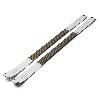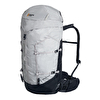Strike! the incredible route at Perda asub 'e pari in Sardinia

 1 / 11
1 / 11 Paolo Contini
Paolo Contini
It may seem like trivial news, three pitches added to a semi-forgotten line, but I believe beautiful routes always deserve the right time and attention to be talked about and rediscovered. Especially if they are exceptional, offer such a huge variety of climbing and are as charming as Strike! As everyone knows, Sardinia is the land of limestone. Those in search of great granite are better off in Italy's Orco Valley and Val di Mello, or Corsica's Bavella. There they'll find clean sheets of rock, tafoni, perfection. But in Sardinia the granite has been rounded over by the wind. The cracks aren't clean but flared, often complicated, the faces are covered in annoying lichen or moss; there's not a crimp or crystal in sight to keep you glued to the mostly too steep slabs. In short, climbing here often isn't a pleasure but a pain. Having said that, in its early stages rock climbing in Sardinia was heavily influenced by what was going on across the pond in California (seems incredible, right?) and the first climbs were forged on the Villacidro granite and, yes, on 7 Fratelli, the 7 Brothers.
The first routes were climbed on Garibaldi in the seventies by a small group of climbers from Cagliari and one of these lines was called Strike: a mere three pitches and a practically perfect corner. In all honesty, when I climbed it back in 1984 - just 4 years after the first ascent - it didn't seem like anything special although this granite outing did seem clean enough. But when I returned last winter, during two terribly windy days, I thought to myself that there was something fascinating about this climbing which, in days gone past, perhaps I had failed to grasp. Times change and with it our perception, too! Maybe what in the past was the norm now seems like something particularly beautiful, simply because no one does that sort of thing any longer!
Numbed by the cold and the biting Mistral wind we decided to give up after the second pitch. But instead of abseiling off, as everyone else would have done, we crept into a crack and, 40 metres later, crawled out on the other side of the mountain where absolute calm reigned supreme! This peak, known locally as "One stone on top of the other", always holds surprises in store! It's a maze of tunnels which lead from one side to the other; boulders the size of houses, stacked on top of each other, clefts and fissures that seem to stem from the centre of the earth. You really won't believe your eyes! While crawling like a caver I couldn't help think about that chimney on Nautilus, the really famous route in Val dell'Orco which excites repeaters as they enter into the bowels of the Sergent rock face. What would they say were they to climb here? And why are there always so many climbers at Nautilus and no one here?
It was blatant that Strike was unfinished business. Above the third pitch it was obvious that the mountain continued. Why had Corrado Pibiri, back in 1980, not dared to go any further? Thanks to having carefully observed Garibaldi during my winter visits I had finally solved the riddle of the upper section and had identified a possible line to the top. I obviously invited Corrado to join me. From the ledge I wanted to climb the slanting slab but given the lichen it would need some cleaning beforehand. When we got there though we realised that we could venture into the mountain once again, climb it from the inside and exit higher up!
Pitch five greeted us as difficult slab traverse. Once again the wind blew impetuously from the west and I battled hard to keep stuck to the face. When I noticed a hole below the gigantic final boulder I didn't dare traverse further. I crawled inside with the rope and all my Friends and crawled out on all fours on the other side onto a granite platform. A tree smiled at me, beckoning to make a stance. A strange chimney and slab pitch, reminiscent of Yosemite, led us to the summit at last.
If I've chosen to introduce this route to you it's because I believe it's something special and therefore deserves a visit. Maybe, yes, maybe I've never climbed such a strange route before! Each pitch is so different from the one before and the route holds so many surprises in store. It's so beautiful to discover these as you climb that it's almost a shame to reveal the plot. But with all its variations and natural mazes, you might well get lost. So, after Corrado's story, I'll provide a brief route description. And, just like with films, those who prefer adventure and surprises can simply skip this part!
Strike. One last bolt by Corrado Pibiri
"Come on Corrado, it's getting late! Why not drill a hole right there" Chicco asked while it was getting dark and there was a risk that forest entrance would be barred shut by the wardens.
"Seeing that I've got some more gas I'll just place one last bolt" I replied "and so maybe next Sunday we'll continue and perhaps create another nice pitch."
That was back in 1991 and Chicco had willingly agreed to help sort some of the belays on Garibaldi seeing that Daniele had kindly lent us his petrol-driven drill...
The belays needed fixing as over 10 years had passed since the routes had been first climbed..
"I promise you, Chicco, we'll only fix the belays." I said, "Since the routes had been established by trad means, I certainly won't be the one who changes their nature by adding bolts."
"What? On the crux of Stike you'd place a bolt though" he replied, puzzled.
It's true, I'd placed one. But that had been the only exception.
The crux, more or less halfway up the pitch, had always proven difficult to protect. The crack flares and even today, with Friends, this seems a bit dodgy.
For years a wooden wedge remained in-situ, as did a knife-blade peg. I still remember that back then - in 1980 and without knowing what Friends were - I failed to invent anything better than that.
And what about the off-width crack on pitch two?
All I remember is that I was really put off when, on reaching it, I realised that my hexentric #11, the largest on the market, wouldn't wedge in because it was too small. I returned empty-handed and got my father to pull a few strings: he had been lifelong friends with a carpenter at Villanova.
The CAI manuals stated that wedges needed to be carved from ash wood?
So ash it would be!
Good old Mario came home all proud with a wedge that weighed at least 1 kilo. And so all we had to do was wait for following Sunday.
A bit of good luck always helps: at 8.00am on Tuesday morning I discovered that the faculty was closed because of a strike and so I didn't think twice and called Bruno.
"Bruno, everything's shut here because of a general strike"
"I too am on strike!" he replied quickly.
"And so? Garibaldi?" I asked anxiously
"Garibaldi!" Bruno replied without hesitation.
The wedge turned out to be perfect and the wood of excellent quality, seeing that it's still there, 33 years later.
And so, being the good language learner that I was, I couldn't help but call this route "Strike".
And that famous bolt?
"Hey Corrado, what do you reckon to trying to add some more pitches to Strike?" Maurizio asked me over the phone a few weeks ago, "You know, there where you placed that bolt so many years ago."
"Why not?" I answered. "After so many years" I think to myself "the time has surely come!"
I was elated to watch Maurizio climb fast and safely up that beautiful pitch, using that bolt as the first pro. And this is how on Garibaldi, throughout the decades, the magic continues. Meaningful and, always, highly exciting.
TOPO: Strike! the incredible route up Perda asub 'e par, Sardina



 Copia link
Copia link









 See all photos
See all photos






















